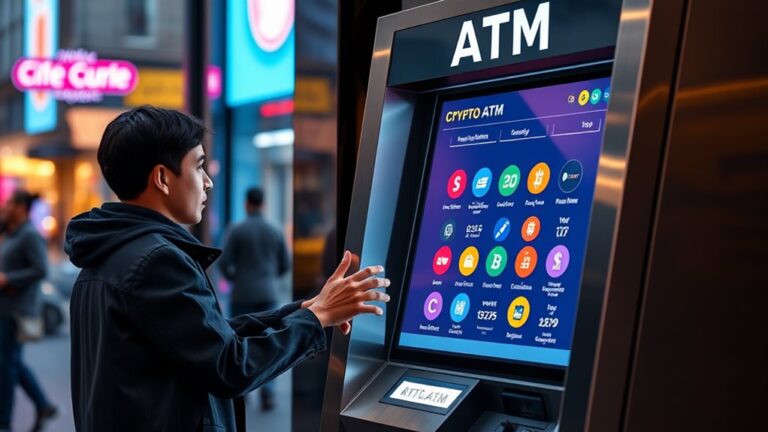
Lightning Network and Fast Payments: How Bitcoin Transactions Get Boosted
The Lightning Network enhances Bitcoin transactions by allowing users to conduct off-chain payments through established payment channels. These channels enable instant transactions with considerably lower fees, making small payments more feasible. By reducing the load on the main blockchain, the Lightning Network addresses scalability issues that Bitcoin faces. This innovation allows for millions of transactions per second, promoting faster and cheaper transfers while increasing privacy. More insights into its real-world applications and challenges await exploration.
Key Takeaways
- The Lightning Network enables off-chain transactions, significantly speeding up Bitcoin payments by reducing reliance on the main blockchain.
- Payment channels allow users to execute transactions instantly, often completing in milliseconds to seconds, enhancing overall transaction speed.
- Lower transaction fees, often fractions of a cent, make micro-payments feasible and encourage more frequent transactions.
- The network’s capacity to handle millions of transactions per second addresses scalability challenges, improving user experience for Bitcoin payments.
- Enhanced privacy in off-chain transactions keeps payment details confidential until the channel is closed, promoting secure exchanges.
Understanding the Lightning Network

The Lightning Network, a significant advancement in cryptocurrency technology, was created to address the scalability challenges faced by Bitcoin. Proposed in 2016 by Joseph Poon and Thaddeus Dryja, it serves as a layer 2 solution aimed at enhancing transaction speed and efficiency.
By operating off-chain, the Lightning Network allows for faster and cheaper transactions compared to the main Bitcoin blockchain. Its primary objective is to increase the number of transactions Bitcoin can handle while reducing costs.
This innovation not only alleviates blockchain congestion but also broadens Bitcoin’s use cases beyond simple payments, making it suitable for various financial applications. As a result, the Lightning Network is an essential development in the ongoing evolution of cryptocurrency technology.
How Payment Channels Work

Payment channels serve as a foundational element in the Lightning Network, enabling quick and efficient Bitcoin transactions.
The process begins with two parties opening a channel by depositing Bitcoin into a multisignature wallet, which requires both parties’ approval for any transactions.
Once established, these channels facilitate off-chain transactions that are governed by smart contracts, ensuring security and efficiency while minimizing costs and delays.
Channel Opening Process
Opening a channel in the Lightning Network involves a series of important steps that establish a secure and efficient payment pathway between users.
Initially, users must install Bitcoin Core and configure Lightning node software, such as LND or Core Lightning. Next, they create a 2-of-2 multisignature wallet, which requires signatures from both parties for transactions.
The process begins with an on-chain funding transaction, where users deposit Bitcoin into the wallet. After both parties sign the channel state, the channel can be considered active once the transaction is confirmed on the blockchain.
Users then connect with peers by providing node details, enabling them to interact within the network efficiently. This structured approach guarantees a reliable channel for future transactions.
Off-Chain Transaction Mechanics
Off-chain transactions form the backbone of the Lightning Network, allowing users to conduct transactions without immediate updates to the Bitcoin blockchain.
These transactions occur within payment channels, which are agreements between two parties to exchange funds without burdening the main blockchain. This method addresses Bitcoin’s scalability issues by reducing transaction times and costs.
Off-chain transactions are greatly faster and avoid high mining fees, making them ideal for small or micro-payments. Enhanced privacy is another key advantage, as transactions within these channels remain confidential until the channel is closed.
Smart Contract Security
Smart contracts serve as the foundational framework for the efficient operation of payment channels within the Lightning Network.
These contracts, created with Bitcoin’s scripting language, facilitate fast and secure off-chain transactions. They regulate the opening, functioning, and closure of payment channels, guaranteeing adherence to established rules.
Smart contracts also incorporate security measures such as multi-signature wallets, which require all parties’ approval for transactions, and penalties for broadcasting outdated channel states, which dissuade fraud.
Time-lock mechanisms guarantee payments finalize promptly, while watchtower services monitor channels for potential breaches.
Additionally, onion routing enhances privacy by encrypting transaction messages, enabling only adjacent nodes to see the routing information.
Advantages of Speed and Cost

As the demand for quick and cost-effective payment solutions continues to rise, the Lightning Network emerges as a compelling alternative to traditional blockchain transactions. Its advantages in speed and cost are significant, making it a transformative option for users.
Key benefits include:
- Near-Instant Transactions: Transactions complete in milliseconds to seconds, drastically reducing waiting times.
- Lower Transaction Fees: Costs are often fractions of a cent, making micropayments feasible.
- Scalability Enhancement: It can handle millions of transactions per second, alleviating network congestion.
- Enhanced User Experience: Fast and affordable transactions align with the needs of modern commerce, improving overall satisfaction.
These features not only streamline payments but also promote broader financial inclusion and operational efficiency for businesses.
Real-World Applications of the Lightning Network

How can the Lightning Network transform everyday transactions?
The Lightning Network enhances various real-world applications, demonstrating its versatility and effectiveness. For instance, Twitter has implemented Lightning for Bitcoin tipping, allowing users to engage in social interactions more seamlessly.
In El Salvador, the network facilitates cross-border remittances, improving efficiency in international money transfers. Peer-to-peer exchanges like Paxful utilize Lightning for quick and low-cost transactions.
E-commerce platforms benefit from microtransactions made viable by the network, while businesses can accept Bitcoin through services like OpenNode, ensuring faster settlements.
Additionally, the network supports a circular Bitcoin economy in places like El Zonte, where local transactions thrive, showcasing the potential for increased financial inclusion and broader adoption of cryptocurrency in daily life. Furthermore, by eliminating intermediaries, the Lightning Network offers faster and cost-effective solutions for global financial transactions, similar to blockchain technology.
Challenges Facing the Lightning Network

Despite the promising potential of the Lightning Network to revolutionize Bitcoin transactions, several challenges hinder its widespread adoption and effectiveness.
Key issues include:
- Lack of Liquidity: Low channel capacity and uneven distribution limit transaction capabilities.
- Transaction Fee Complexity: High and unpredictable fees can deter users from utilizing the network for smaller transactions.
- Security Risks: Vulnerabilities from malicious attacks can jeopardize users’ funds, complicating the network’s reliability.
- Adoption Challenges: Many potential users are unaware of the Lightning Network, and integration with existing systems remains slow.
These challenges must be addressed to enhance the usability and appeal of the Lightning Network, ultimately influencing its role in mainstream payment systems.
Future Development and Growth Potential

The Lightning Network stands at a pivotal moment in its development, with significant growth potential on the horizon. Major exchanges like Coinbase and Kraken have already integrated the network, signaling a trend towards broader adoption.
In 2024, more businesses began using the Lightning Network than in previous years, with expectations for continued growth in 2025. Simplified processes for merchant onboarding further enhance market acceptance.
The network is also expanding into sectors such as gaming and eCommerce, improving user experiences with fast transactions. Technological advancements, including Taproot upgrades, enhance scalability and reduce costs.
Frequently Asked Questions
What Wallets Support Lightning Network Transactions?
Several wallets support Lightning Network transactions, including Wallet of Satoshi, Blue Wallet, Muun Wallet, and Phoenix Wallet. These options cater to various user preferences, ranging from custodial to non-custodial solutions with user-friendly interfaces.
Can I Use Lightning Network Offline?
While offline usage of the Lightning Network is currently limited due to the need for real-time connectivity, emerging technologies like PTLCs and trampoline relays aim to facilitate asynchronous payments, enhancing usability for future transactions.
How Do I Open a Lightning Network Channel?
To open a Lightning Network channel, one must select a peer, specify channel capacity and fees, execute the opening command, and await blockchain confirmations, ensuring the node is synced and operational throughout the process.
Is Lightning Network Available in All Countries?
The Lightning Network is not universally available; its accessibility varies by country. Regulatory barriers and uneven node distribution can limit its implementation, although it remains reachable in regions with robust internet connectivity and Bitcoin adoption.
What Happens if a Channel Goes Offline?
When a channel goes offline, concerns arise: congestion, compromised connectivity, and potential fraudulent closures. Without real-time updates, users face operational obstacles, prompting the need for innovative solutions to guarantee security and scalability within the network.
Conclusion
The Lightning Network represents a significant advancement in Bitcoin transactions, transforming the landscape of digital payments. By utilizing payment channels, it allows for swift and cost-effective transactions, much like a river flowing quickly over smooth stones. However, challenges remain, such as scalability and security concerns, which could impede its growth. As the technology develops and matures, the potential for widespread adoption and integration into everyday transactions offers a glimpse of a more efficient financial future, illuminating the path ahead.












